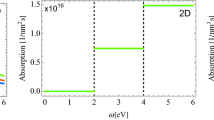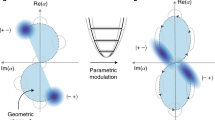Abstract
For bosons, the transition rate into an already occupied quantum state is enhanced by its occupation number: the effect of bosonic stimulation. Bosonic stimulation of light scattering was predicted more than 30 years ago but has proven elusive to direct observation. Here we investigate this effect in an ultracold gas of bosons. We show that the bosonic enhancement factor for a harmonically trapped gas is bounded by a universal constant above the phase transition to a Bose–Einstein condensate and depends linearly on the condensate fraction just below the phase transition. We observe bosonic enhanced light scattering both above and below the phase transition, and we show how interactions can alter the bosonic stimulation and optical properties of the gas. Lastly, we demonstrate that, for a multi-level system prepared in a single internal state, the bosonic enhancement is reduced because it occurs only for Rayleigh scattering but not for Raman scattering.
This is a preview of subscription content, access via your institution
Access options
Access Nature and 54 other Nature Portfolio journals
Get Nature+, our best-value online-access subscription
$29.99 / 30 days
cancel any time
Subscribe to this journal
Receive 12 print issues and online access
$209.00 per year
only $17.42 per issue
Buy this article
- Purchase on Springer Link
- Instant access to full article PDF
Prices may be subject to local taxes which are calculated during checkout




Similar content being viewed by others
Data availability
The data that support the plots within this paper and other findings of this study are available from the corresponding authors upon reasonable request and through Zenodo42.
Code availability
The codes that support the findings of this study are available from the corresponding authors upon reasonable request and through Zenodo43.
Change history
20 January 2023
In the version of this article initially published, the term “light scattering” was missing from the beginning of the abstract and is now amended in the HTML and PDF versions of the article.
References
Miesner, H.-J. et al. Bosonic stimulation in the formation of a Bose–Einstein condensate. Science 279, 1005–1007 (1998).
Esteve, J. et al. Observations of density fluctuations in an elongated Bose gas: ideal gas and quasicondensate regimes. Phys. Rev. Lett. 96, 130403 (2006).
Blumkin, A. et al. Observing atom bunching by the Fourier slice theorem. Phys. Rev. Lett. 110, 265301 (2013).
Inouye, S. et al. Superradiant Rayleigh scattering from a Bose–Einstein condensate. Science 285, 571–574 (1999).
Inouye, S. et al. Phase-coherent amplification of atomic matter waves. Nature 402, 641–644 (1999).
Kozuma, M. et al. Phase-coherent amplification of matter waves. Science 286, 2309–2312 (1999).
Moore, M. G. & Meystre, P. Atomic four-wave mixing: fermions versus bosons. Phys. Rev. Lett. 86, 4199–4202 (2001).
Ketterle, W. & Inouye, S. Does matter wave amplification work for fermions? Phys. Rev. Lett. 86, 4203–4206 (2001).
Yoshikawa, Y., Torii, Y. & Kuga, T. Superradiant light scattering from thermal atomic vapors. Phys. Rev. Lett. 94, 083602 (2005).
Wang, P. et al. Observation of collective atomic recoil motion in a degenerate fermion gas. Phys. Rev. Lett. 106, 210401 (2011).
Svistunov, B. & Shlyapnikov, G. Resonance optics of the low-temperature quantum gases H and D. Sov. Phys. JETP 70, 460–466 (1990).
Politzer, H. D. Light incident on a Bose-condensed gas. Phys. Rev. A 43, 6444–6446 (1991).
Zhang, W. & Walls, D. F. Quantum field theory of interaction of ultracold atoms with a light wave: Bragg scattering in nonlinear atom optics. Phys. Rev. A 49, 3799–3813 (1994).
Morice, O., Castin, Y. & Dalibard, J. Refractive index of a dilute Bose gas. Phys. Rev. A 51, 3896–3901 (1995).
Javanainen, J. & Ruostekoski, J. Off-resonance light scattering from low-temperature Bose and Fermi gases. Phys. Rev. A 52, 3033–3046 (1995).
Javanainen, J. Optical signatures of a tightly confined Bose condensate. Phys. Rev. Lett. 72, 2375–2378 (1994).
Politzer, H. D. Bose-stimulated scattering off a cold atom trap. Phys. Rev. A 55, 1140–1146 (1997).
Bons, P. C., de Haas, R., de Jong, D., Groot, A. & van der Straten, P. Quantum enhancement of the index of refraction in a Bose–Einstein condensate. Phys. Rev. Lett. 116, 173602 (2016). Claimed the observation of bosonic enhancement of light scattering. However, their observable was atom loss caused by optical pumping. As we show in the last part of the paper, optical pumping (that is, Raman scattering) into an unoccupied state does not show any bosonic enhancement. Instead, the observed loss could be caused by inelastic collisions or non-linear light scattering.
Deb, A. B. & Kjærgaard, N. Observation of Pauli blocking in light scattering from quantum degenerate fermions. Science 374, 972–975 (2021). After the experimental work had been completed and presented at the BEC 2021 conference, possible evidence of bosonic stimulation effects was observed in optical absorption measurements which showed an enhancement of 10–15% across the BEC phase transition. However, this effect was explained without considering light scattering involving the condensate, and no full analysis was given (since the topic of the paper was Pauli blocking for fermions).
Inguscio, M., Stringari, S. & Wieman, C. Bose–Einstein Condensation in Atomic Gases, vol. 140 (IOS Press, 1999).
Top, F. Ç., Margalit, Y. & Ketterle, W. Spin-polarized fermions with p-wave interactions. Phys. Rev. A 104, 043311 (2021).
Margalit, Y., Lu, Y.-K., Çağrı Top, F. & Ketterle, W. Pauli blocking of light scattering in degenerate fermions. Science 374, 976–979 (2021).
Sanner, C. et al. Pauli blocking of atom-light scattering. Science 374, 979–983 (2021).
Shuve, B. & Thywissen, J. Enhanced Pauli blocking of light scattering in a trapped Fermi gas. J. Phys. B 43, 015301 (2009).
Naraschewski, M. & Glauber, R. J. Spatial coherence and density correlations of trapped Bose gases. Phys. Rev. A 59, 4595–4607 (1999).
Naraschewski, M. & Stamper-Kurn, D. M. Analytical description of a trapped semi-ideal Bose gas at finite temperature. Phys. Rev. A 58, 2423–2426 (1998).
Stamper-Kurn, D. M. et al. Excitation of phonons in a Bose-Einstein condensate by light scattering. Phys. Rev. Lett. 83, 2876–2879 (1999).
Schneble, D. et al. Raman amplification of matter waves. Phys. Rev. A 69, 041601 (2004).
Yoshikawa, Y., Sugiura, T., Torii, Y. & Kuga, T. Observation of superradiant Raman scattering in a Bose–Einstein condensate. Phys. Rev. A 69, 041603 (2004).
Zhu, B., Cooper, J., Ye, J. & Rey, A. M. Light scattering from dense cold atomic media. Phys. Rev. A 94, 023612 (2016).
Weiner, J., Bagnato, V. S., Zilio, S. & Julienne, P. S. Experiments and theory in cold and ultracold collisions. Rev. Mod. Phys. 71, 1–85 (1999).
Dicke, R. H. Coherence in spontaneous radiation processes. Phys. Rev. 93, 99–110 (1954).
Navon, N., Smith, R. P. & Hadzibabic, Z. Quantum gases in optical boxes. Nat. Phys. 17, 1334–1341 (2021).
Ketterle, W., Durfee, D. S. & Stamper-Kurn, D. M. Making, probing and understanding Bose–Einstein condensates. In Bose–Einstein Condensation in Atomic Gases (eds Inguscio, M. et al.) 67–176 (IOS Press, 1999).
Görlitz, A. et al. Sodium Bose–Einstein condensates in the F = 2 state in a large-volume optical trap. Phys. Rev. Lett. 90, 090401 (2003).
Li, M., Chen, L. & Chen, C. Density of states of particles in a generic power-law potential in any dimensional space. Phys. Rev. A 59, 3109–3111 (1999).
Pethick, C. J. & Smith, H. Bose–Einstein Condensation in Dilute Gases (Cambridge Univ. Press, 2008).
Mordini, C. hfsolver: a numerical solver for the Hartree-Fock equation of state of a homogeneous Bose gas. Github https://github.com/carmelom/hfsolver (2019).
Meppelink, R., Rozendaal, R. A., Koller, S. B., Vogels, J. M. & van der Straten, P. Thermodynamics of Bose-Einstein-condensed clouds using phase-contrast imaging. Phys. Rev. A 81, 053632 (2010).
Proukakis, N. P., Snoke, D. W. & Littlewood, P. B. Universal Themes of Bose–Einstein Condensation (Cambridge Univ. Press, 2017).
Ketterle, W. & Miesner, H.-J. Coherence properties of Bose–Einstein condensates and atom lasers. Phys. Rev. A 56, 3291–3293 (1997).
Lu, Y.-K. Data for figures in “Observation of bosonic stimulation in light scattering” (arXiv:2204.06639). Zenodo https://doi.org/10.5281/zenodo.7158468 (2022).
Lu, Y.-K. Code for calculations in “Observation of bosonic stimulation in light scattering” (arXiv:2204.06639). Zenodo https://doi.org/10.5281/zenodo.7158514 (2022).
Acknowledgements
We thank Z. Hadzibabic, J. de Hond and P. Barral for comments on the manuscript. This work is supported by NSF through the Center for Ultracold Atoms and grant no. 1506369, and from a Vannevar-Bush Faculty Fellowship.
Author information
Authors and Affiliations
Contributions
All authors contributed to the concepts of the experiment, Y.-K.L. and Y.M. performed the experiment, Y.-K.L. analysed the data and performed the theoretical calculations. Y.-K.L., Y.M. and W.K. wrote the paper.
Corresponding author
Ethics declarations
Competing interests
The authors declare no competing interests.
Peer review
Peer review information
Nature Physics thanks the anonymous reviewers for their contribution to the peer review of this work.
Additional information
Publisher’s note Springer Nature remains neutral with regard to jurisdictional claims in published maps and institutional affiliations.
Extended data
Extended Data Fig. 1 Linearity check for light scattering.
Scattered photons are measured for different probe beam powers. The blue (red) data points represent a cloud with (without) BEC. The absence of nonlinearity shows that we are working in the perturbative regime. Data points here are each averaged over 3 samples.
Extended Data Fig. 2 Light scattering after compressing the cloud.
The photon scattering signal was measured for different final trap depths. The dashed line represents the signal observed for a non-degenerate cloud with no bosonic enhancement. Each data point was averaged over 6 samples.
Extended Data Fig. 3 Bosonic enhancement factor for an ideal gas in a 3D box potential for different recoil momenta κ.
At the phase transition point, the bosonic enhancement factor diverges as 1/κ.
Extended Data Fig. 4 Bosonic enhancement factor for an ideal gas in a 3D harmonic trapping potential for different recoil momenta κ.
The enhancement factor is bounded at and above the phase transition, but will diverge as 1/κ2 below the phase transition.
Extended Data Fig. 5 The density distribution of the condensate and thermal cloud for different models.
In the calculations we used the following values: scattering length of a = 85a0 (a0 is the Bohr radius), trap frequency ω = 2π × 2.7kHz, atom number N = 4 × 105 and condensate fraction of 30%.
Extended Data Fig. 6 Comparison between different models above the phase transition.
(a) Predictions for the Bose enhancement factor for different models. (b) Fitting of the models to the experimental data. The only free parameter is the overall scaling. In the calculations we used the following parameters: scattering length a = 85a0 (a0 is the Bohr radius), atom number N = 4 × 105 and dimensionless recoil momentum κ = 0.51.
Extended Data Table 1 Bosonic enhancement factor for different exponent x in the density of states.
In the limit of zero recoil momentum, the enhancement factor is bounded for x ≤ 0 and x > 1 while diverging for 0 < x ≤ 1.
Extended Data Table 2 χ2 values for fits using different models.
The χ2 values are normalized in such a way that it becomes dof = 13 for the full interacting model. As a comparison, the probability for χ2 (dof=13) to be larger than 18.5 is 10%.
Supplementary information
Supplementary Information
Supplementary discussion and Fig. 1.
Rights and permissions
Springer Nature or its licensor (e.g. a society or other partner) holds exclusive rights to this article under a publishing agreement with the author(s) or other rightsholder(s); author self-archiving of the accepted manuscript version of this article is solely governed by the terms of such publishing agreement and applicable law.
About this article
Cite this article
Lu, YK., Margalit, Y. & Ketterle, W. Bosonic stimulation of atom–light scattering in an ultracold gas. Nat. Phys. 19, 210–214 (2023). https://doi.org/10.1038/s41567-022-01846-y
Received:
Accepted:
Published:
Issue Date:
DOI: https://doi.org/10.1038/s41567-022-01846-y
This article is cited by
-
Quantum back-action limits in dispersively measured Bose-Einstein condensates
Communications Physics (2023)



